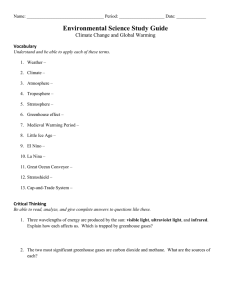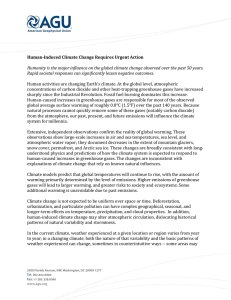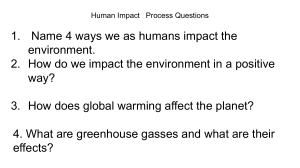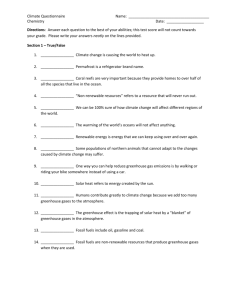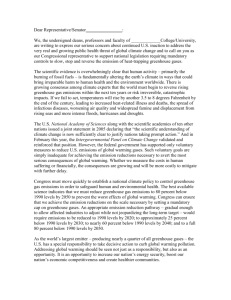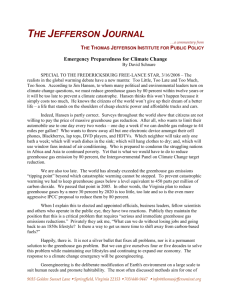Environmental Science and Climate Change Unit 1 Review answer
advertisement
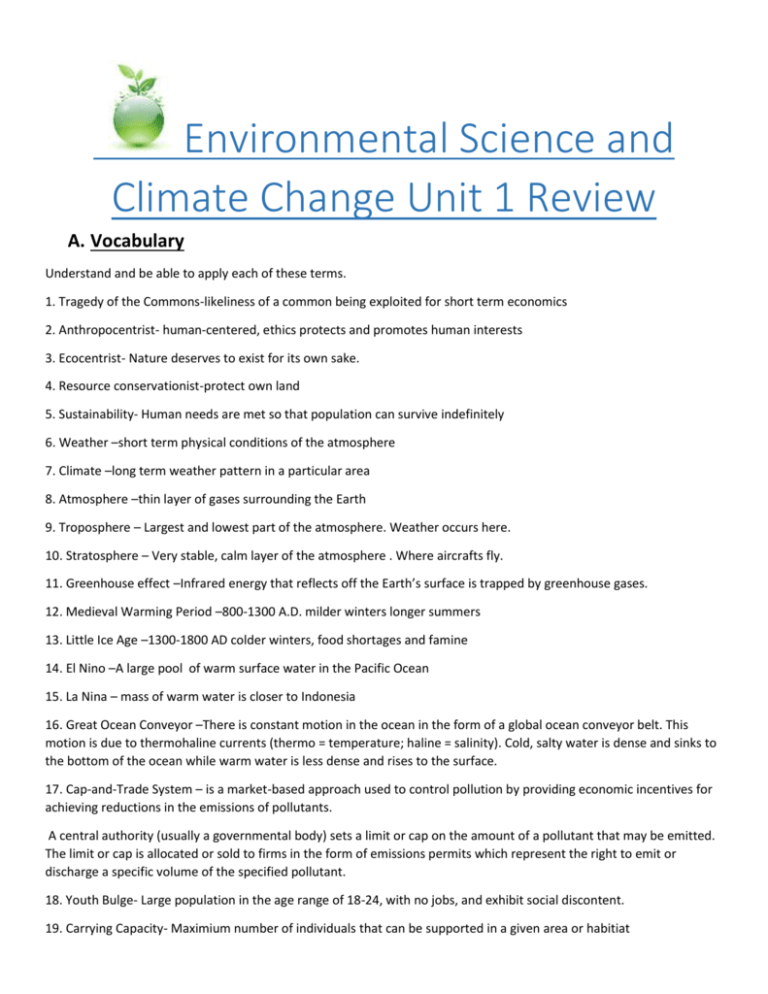
Environmental Science and Climate Change Unit 1 Review A. Vocabulary Understand and be able to apply each of these terms. 1. Tragedy of the Commons-likeliness of a common being exploited for short term economics 2. Anthropocentrist- human-centered, ethics protects and promotes human interests 3. Ecocentrist- Nature deserves to exist for its own sake. 4. Resource conservationist-protect own land 5. Sustainability- Human needs are met so that population can survive indefinitely 6. Weather –short term physical conditions of the atmosphere 7. Climate –long term weather pattern in a particular area 8. Atmosphere –thin layer of gases surrounding the Earth 9. Troposphere – Largest and lowest part of the atmosphere. Weather occurs here. 10. Stratosphere – Very stable, calm layer of the atmosphere . Where aircrafts fly. 11. Greenhouse effect –Infrared energy that reflects off the Earth’s surface is trapped by greenhouse gases. 12. Medieval Warming Period –800-1300 A.D. milder winters longer summers 13. Little Ice Age –1300-1800 AD colder winters, food shortages and famine 14. El Nino –A large pool of warm surface water in the Pacific Ocean 15. La Nina – mass of warm water is closer to Indonesia 16. Great Ocean Conveyor –There is constant motion in the ocean in the form of a global ocean conveyor belt. This motion is due to thermohaline currents (thermo = temperature; haline = salinity). Cold, salty water is dense and sinks to the bottom of the ocean while warm water is less dense and rises to the surface. 17. Cap-and-Trade System – is a market-based approach used to control pollution by providing economic incentives for achieving reductions in the emissions of pollutants. A central authority (usually a governmental body) sets a limit or cap on the amount of a pollutant that may be emitted. The limit or cap is allocated or sold to firms in the form of emissions permits which represent the right to emit or discharge a specific volume of the specified pollutant. 18. Youth Bulge- Large population in the age range of 18-24, with no jobs, and exhibit social discontent. 19. Carrying Capacity- Maximium number of individuals that can be supported in a given area or habitiat 20. Environment- Study of interactions of humans within their natural environment. B. Short Answer Questions Be able to read, analyze, and give complete answers to questions like these. 1. How large is Canada’s ecological footprint compared to other countries? Give three reasons why this is? 2.3 times larger- Energy use, transportation, food. 2. What is the difference between developed and a developing country? Be able to give 2 differences. Developed have higher incomes, longer life expectancy, slower population growth. Developing Country- shorter life span, overpopulated, less environmental protections. 3. What is zero population growth? When will this occur? Is when a population is not increasing. When births = death rate in a population. 4. Use a past society as an example of how a society reached its carrying capacity. Explain what happened to this society. Easter Island- cut down all trees, Vikings- blocked off from trade, Anasazi5. Three wavelengths of energy are produced by the sun: visible light, ultraviolet light, and infrared. Which is trapped by greenhouse gases? Infared light 6. The two most significant greenhouse gases are carbon dioxide and methane. What are the sources of each? CO2from energy sources, methane – from animal waste 7. What is the largest greenhouse gas contributor? 8. What do scientists predict will happen in the next century? 9. Explain how global warming can alter the hydrologic cycle to cause climate change. 10. Climate change is a process that has occurred naturally at different points in the Earth’s history. Give an example of a natural cause of global climate change. 11. How much has the Earth’s average surface temperature increased since 1880? At what rate is the Earth’s surface currently warming? 12. Why is the carbon dioxide detector located in Hawaii? 13. Explain why the average carbon dioxide readings are higher during the winter and colder during the summer. 14. Direct measurements of temperature are only recorded as far back as 1880. Where does the data come from before that? 15. Explain how the Once-ler impacted his environment and explain how he could have prevented this from happening. (3 impacts) 16. What is the relationship between global warming and hurricanes? 17. What continent would be most affected by a disruption in the great ocean conveyor? 18. What effect is global warming having on sea levels? Why is this happening? 19. Give an example of a global warming prevention and cleanup strategy. 20. What can be done to reduce CO2 emissions? 21. Explain how carbon capture works? 22. What is a global commons and give four examples. 23. Give an example of a Negative/ Positive Feedback loop

